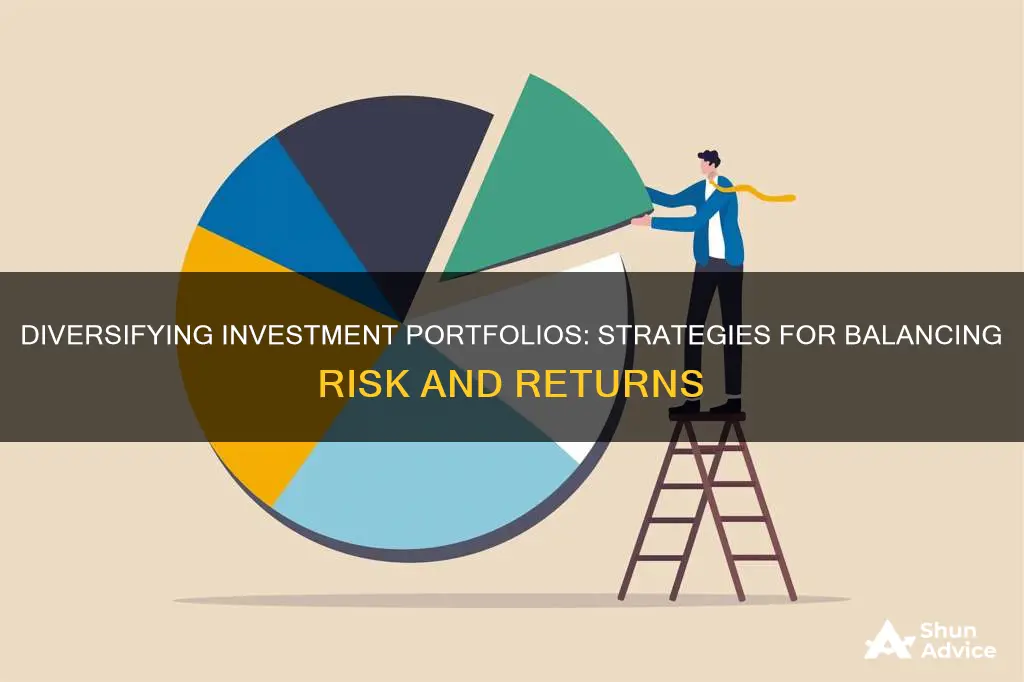
Diversifying your investment portfolio is a crucial step in managing your risk and optimising your returns. The core principle behind diversification is not putting all your eggs in one basket, which means that you should spread your investments across different asset classes, industries, and markets to reduce the impact of any single investment on your portfolio's performance. Diversification can help you achieve higher returns while minimising the volatility and risk associated with investing in a single asset or industry.
By diversifying your portfolio, you can lower the chances of significant losses due to underperforming investments and increase the potential for overall positive returns. In this paragraph, we will explore the key benefits of diversification and provide an overview of how you can effectively diversify your investment portfolio.
| Characteristics | Values |
|---|---|
| Number of different investments | 20-30 |
| Types of investment | Equities, commodities, exchange-traded funds (ETFs), real estate investment trusts (REITs), index funds, fixed-income funds, cash, bonds, target-date funds, mutual funds, cryptocurrencies, gold, certificates of deposit (CDs), hedge funds, private equity, debt investing, commodities, collectibles, structured products |
| Geographic diversification | Domestic and international markets |
| Risk diversification | High- and low-risk stocks |
What You'll Learn

Diversify your stocks
Diversifying your stocks is a crucial aspect of any investment plan. Here are some detailed strategies to help you diversify your stocks and build a robust investment portfolio:
Diversify Across Different Sectors and Industries:
Avoid concentrating your stock holdings in a single sector or industry. For instance, if you heavily invested in technology stocks during the late 1990s, your portfolio would have lacked diversification because those stocks were influenced by similar market trends and factors. The Nasdaq Composite Index, predominantly comprising tech stocks, plummeted by almost 80% between March 2000 and fall 2002. Thus, it's essential to spread your investments across various sectors and industries to reduce the risk of being overly exposed to a specific market segment.
Utilize Index Funds:
Index funds, such as ETFs (Exchange-Traded Funds) and mutual funds, offer a straightforward way to diversify your stock portfolio. These funds track broad market indexes like the S&P 500, enabling you to invest in a diverse range of companies with minimal management fees. Index funds are a convenient option for investors seeking a more passive approach to portfolio management. Additionally, you can use index funds to gain exposure to specific sectors or industries in which you may be underinvested. However, keep in mind that funds focused on particular sectors or industries may have higher expenses.
Include International Stocks:
Don't limit yourself to domestic stocks; consider investing in international stocks as well. Exploring investment opportunities in emerging markets or regions like Europe can provide exposure to different economies and potentially higher long-term growth rates. International diversification also helps protect your portfolio from negative events specific to the U.S. market. However, remember that emerging markets may experience bumps in their growth trajectories due to challenges associated with their developing economies and financial markets.
Maintain a Balanced Mix of Stocks and Other Investments:
While stocks are a crucial component of your portfolio, ensure you also allocate a portion of your investments to other asset classes, such as bonds and cash. This strategy helps manage risk and smoothen out the peaks and valleys of the stock market. The ratio of stocks to bonds in your portfolio can be adjusted based on your investment time frame, financial goals, and risk tolerance. Generally, if you're investing for the long term and can withstand market volatility, a larger proportion of your portfolio can be dedicated to stocks. On the other hand, if you need the money in a few years or prefer a more conservative approach, consider allocating more to bonds and cash, which are typically less volatile.
Regularly Rebalance Your Portfolio:
Over time, the performance of different investments in your portfolio will vary, causing shifts in their weightings. Therefore, it's essential to periodically rebalance your portfolio to maintain the desired allocation for each investment. This process typically involves buying or selling certain assets to return them to their appropriate weightings. For example, if stocks have had a strong run, their allocation in your portfolio may have increased, necessitating a rebalancing to reduce the risk associated with being overly exposed to stocks.
Set a Risk Level You're Comfortable With:
Before constructing your stock portfolio, it's crucial to define your risk tolerance and investment goals. Ask yourself how much risk you're comfortable taking and how much volatility you can withstand. This introspection will guide your investment choices and help you build a portfolio aligned with your personal financial situation and objectives.
Remember, diversification is a dynamic process that requires regular monitoring and adjustments. By diversifying your stocks across sectors, industries, and geographies, as well as incorporating other asset classes, you can better manage risk and improve the potential for higher returns over the long term.
Smart Saving and Investing Strategies for Your Kids' Future
You may want to see also

Diversify your bonds
Diversifying your investment portfolio with bonds can be a great way to balance out the volatility of equities and provide a stable source of income. Bonds are loans made to governments, government agencies, or corporations, which are then used to finance projects and other needs. The bond issuer agrees to repay the bondholder with interest by a specified maturity date.
Focus on High-Quality Bonds
High-quality bonds, such as Treasury bonds and corporate debt securities, are a good choice for diversifying your portfolio. These bonds are issued by stable governments or established companies with strong financial stability and success. They tend to be less volatile and hold their value better during economic uncertainty. Examples include U.S. Treasury bonds, municipal bonds, and corporate bonds.
Assess Bond Quality with Ratings
Not all bonds are created equal, so it's important to assess their quality. Bond ratings are assigned by independent ratings agencies, and investment-grade bonds have a lower risk of default. For example, on the Moody's scale, investment-grade bonds are rated BAA or higher, while on the Standard & Poor's and Fitch scales, they are rated BBB or higher.
Consider Different Types of Bonds
Just as there are various types of equities, there are different types of bonds to choose from. Government bonds, municipal bonds, agency bonds, corporate bonds, and mortgage-backed securities all have unique characteristics and risk profiles. By diversifying across different types of bonds, you can further reduce your overall risk.
Vary Maturities, Credit Qualities, and Durations
When investing in bonds, consider varying the maturities, credit qualities, and durations of your bond holdings. Bonds with shorter maturities are less sensitive to interest rate changes, while longer-maturity bonds may provide higher yields but carry greater interest rate risk. Diversifying across these factors can help manage your overall risk exposure.
Include Bonds in Your Overall Asset Allocation
A well-diversified portfolio typically includes a mix of stocks, bonds, and cash. While the specific mix depends on your objectives, investment horizon, and risk tolerance, a general rule of thumb is to allocate 60% to equities and 40% to fixed-income investments, including bonds.
Use Bond Funds for Diversification
Investing in bond funds, such as mutual funds or exchange-traded funds (ETFs), can provide even greater diversification. These funds pool together many loans from different investors, reducing the risk associated with individual bonds. Vanguard, for example, offers over 100 bond funds to choose from.
By following these strategies, you can effectively diversify your portfolio with bonds, reducing risk and enhancing the stability of your investment portfolio.
Yotta Savings: A Smart Investment Strategy for Your Money
You may want to see also

Diversify your cash
Diversifying your cash investments is an important part of any investment strategy. While it is a near certainty that cash will lose value over time due to inflation, it can still be a valuable part of your portfolio. Here are some ways to diversify your cash investments:
Money Market Instruments
Money market instruments such as certificates of deposit (CDs), commercial papers (CPs), and treasury bills (T-bills) offer a safe and liquid option for cash investment. T-bills, in particular, are considered close to risk-free as they are backed by the central government and insulated from market fluctuations. While these instruments may not offer high returns, they can be a good place to park your money in the short term or to offset against riskier investments.
Mutual Funds with Systematic Cash Flow
Mutual funds with systematic cash flow, also known as systematic withdrawal plans (SWP), allow you to access your money even while it is locked in a savings plan. With SWP, you can withdraw a fixed amount monthly or quarterly, either as a fixed sum or against profits. A similar option is a systematic transfer plan (STP), where you transfer a fixed amount between mutual funds to maintain a balance in your portfolio.
Target-Date Funds
Target-date funds are a great option if you're looking for a "set it and forget it" approach to investing. These funds automatically adjust your asset allocation based on your chosen investment goal and time horizon. When you're far from your goal, they invest in riskier but higher-return assets like stocks, and as you get closer, they shift towards safer options like bonds or cash.
Global Markets
Investing in global markets can offer the potential for high returns in a short amount of time. Exchange-traded funds (ETFs) or mutual funds with a low-cost structure and ample liquidity can be a good way to get started in international investing. Just be sure to understand the different monetary regulations and dynamics of the markets you're investing in.
Life Insurance
Life insurance, particularly unit-linked insurance plans (ULIPs), can be a good investment option, especially when you're young and premiums are lower. ULIPs combine life insurance with market-linked investments, allowing you to invest for future milestones while also safeguarding your loved ones.
Remember, when diversifying your cash investments, it's important to consider your overall investment goals, risk tolerance, and financial circumstances. It's also crucial to periodically review and rebalance your portfolio to maintain the appropriate asset allocation.
Savings and Investments: Strategies for Success in Lean Times
You may want to see also

Diversify your commodities
Diversifying your commodities is a crucial aspect of building a robust investment portfolio. Here are some detailed strategies to help you diversify your commodities effectively:
Volatile Assets
Volatile assets, such as commodities, can be beneficial for diversification. Their volatile price movements create opportunities to buy low and sell high through a process called rebalancing. This strategy involves periodically adjusting your portfolio to return to your desired asset allocation. For example, if the price of a commodity increases significantly, you can sell a portion of it to lock in profits and bring your portfolio back to its target weights.
Uncorrelated Returns
Diversification works best when your investments have uncorrelated returns. This means that the performance of one investment is not closely tied to another. By investing in commodities with uncorrelated returns, you reduce the risk of your entire portfolio being affected by the same market forces. For instance, consider investing in a range of commodities from different sectors, such as energy, grains, and metals, rather than solely focusing on one sector.
Positive Expected Return
When selecting commodities for your portfolio, it's essential to consider those with a positive expected return. This means that the commodity is expected to generate profits over time. By including these commodities, you ensure that your investments contribute positively to your portfolio's overall performance, even as you rebalance and adjust your holdings.
Cyclical Returns
Commodity returns often move in cycles, and these cycles can be deeper and longer than those of equities. Therefore, it's crucial to monitor these cycles and make informed decisions about when to enter and exit the market. For example, if a particular commodity is experiencing a prolonged bear market, it may be wise to wait for signs of a rally before investing.
Exposure and Allocation
There are different ways to gain exposure to commodities. You can use overlay strategies, which involve shorting cash exposure, or you can fully fund commodity exposures, replacing another asset in your portfolio. In terms of allocation, a general rule of thumb is to allocate 2% to 5% of your portfolio to commodities. This range is enough to make a meaningful impact without taking on excessive risk.
Benefits of Commodities in Your Portfolio
Commodities can provide benefits to your portfolio, especially in certain market conditions. For instance, if inflation concerns arise due to monetary and fiscal policy stimulus, commodities can be a valuable hedge against inflation. Additionally, commodities can help diversify your portfolio when traditional fixed-income allocations, such as Treasuries, are not providing the same level of diversification as they have in the past.
Remember, diversification is a dynamic process that requires regular monitoring and adjustments. Keep yourself informed about market conditions and be prepared to act when necessary to maintain a well-diversified portfolio.
The Emotional Rewards of Saving and Investing
You may want to see also

Diversify your real estate
Diversifying your real estate portfolio is a great way to manage risk and maximise returns. Here are some strategies to help you diversify:
Diversify by Asset Type
The variety of different asset types is one of the benefits of investing in real estate. You can choose to invest in anything from single-family homes to large apartment complexes, retail spaces, industrial buildings, office spaces, self-storage units, and more. By investing in different types of assets, you can protect yourself from broader macro changes to the economy, such as the shift towards e-commerce or the move towards remote work, which can impact the demand for retail spaces and office spaces.
Diversify by Geographical Location
Real estate is hyperlocal, meaning that the performance of the market in one city or town can vary significantly from another. By diversifying your investments across different geographical locations, you can take advantage of the ups and downs of various markets and reduce your exposure to a slowdown or correction in any one market. Look for markets with high job growth, population growth, and job diversity to maximise the growth potential of your portfolio.
Diversify by Asset Class
Understanding human behaviour during booms and busts is essential for diversifying by asset class. For example, during good economic times, people tend to rent larger and more luxurious apartments in desirable areas. However, during tough economic times, they may need to downsize or opt for more moderately priced accommodations. By investing in a mix of asset classes, you can ensure that your portfolio performs well across different parts of the market cycle.
Diversify by Strategy and Hold Time
Another strategy for diversification is to vary your investment approach and hold time. While some properties may be suitable for a buy-and-hold strategy, others may benefit from a different approach, such as the BRRRR method (buy, rehab, rent, refinance, repeat). Additionally, you may have different horizons for each property, with some being shorter-term investments and others being long-term holdings or even generational wealth passed down to your family.
Diversify by Active vs. Passive Investing
Introducing a mix of active and passive real estate investments can also help diversify your portfolio. Active investments typically involve managing and operating smaller residential rental properties yourself. On the other hand, passive investments often involve larger commercial properties, such as apartment buildings, managed by professional syndicators. Passive investments can provide access to new strategies and markets that may not be available through active investing alone.
Monthly Savings: Where to Invest for Maximum Returns
You may want to see also
Frequently asked questions
Diversification is a way to manage risk in your portfolio by investing in a variety of asset classes and in different investments within asset classes. The idea is that if one stock, sector, or asset class slumps, others may rise.
Here are some strategies to help you diversify your portfolio:
- Invest in a variety of stocks from different sectors and industries.
- Consider adding fixed-income assets like bonds to lower volatility and risk.
- Include some non-correlated investments, such as real estate, gold, or cryptocurrencies.
- Look beyond your home country and invest in international markets.
Diversification helps to reduce the overall risk of your portfolio while potentially increasing overall returns. By investing in a variety of assets, you minimize the chances of any one asset severely impacting your portfolio. Diversification can also help smooth out the peaks and valleys of investing, making it easier to stick to your investment plan.
To get started with diversification, consider the following:
- Determine your investment goals, time frame, risk tolerance, and financial circumstances.
- Choose a mix of asset classes (e.g. stocks, bonds, cash, real estate) that align with your investment strategy.
- Invest in a variety of stocks or consider purchasing an index fund that tracks a broad market index.
- Regularly review and rebalance your portfolio to maintain your desired asset allocation.







